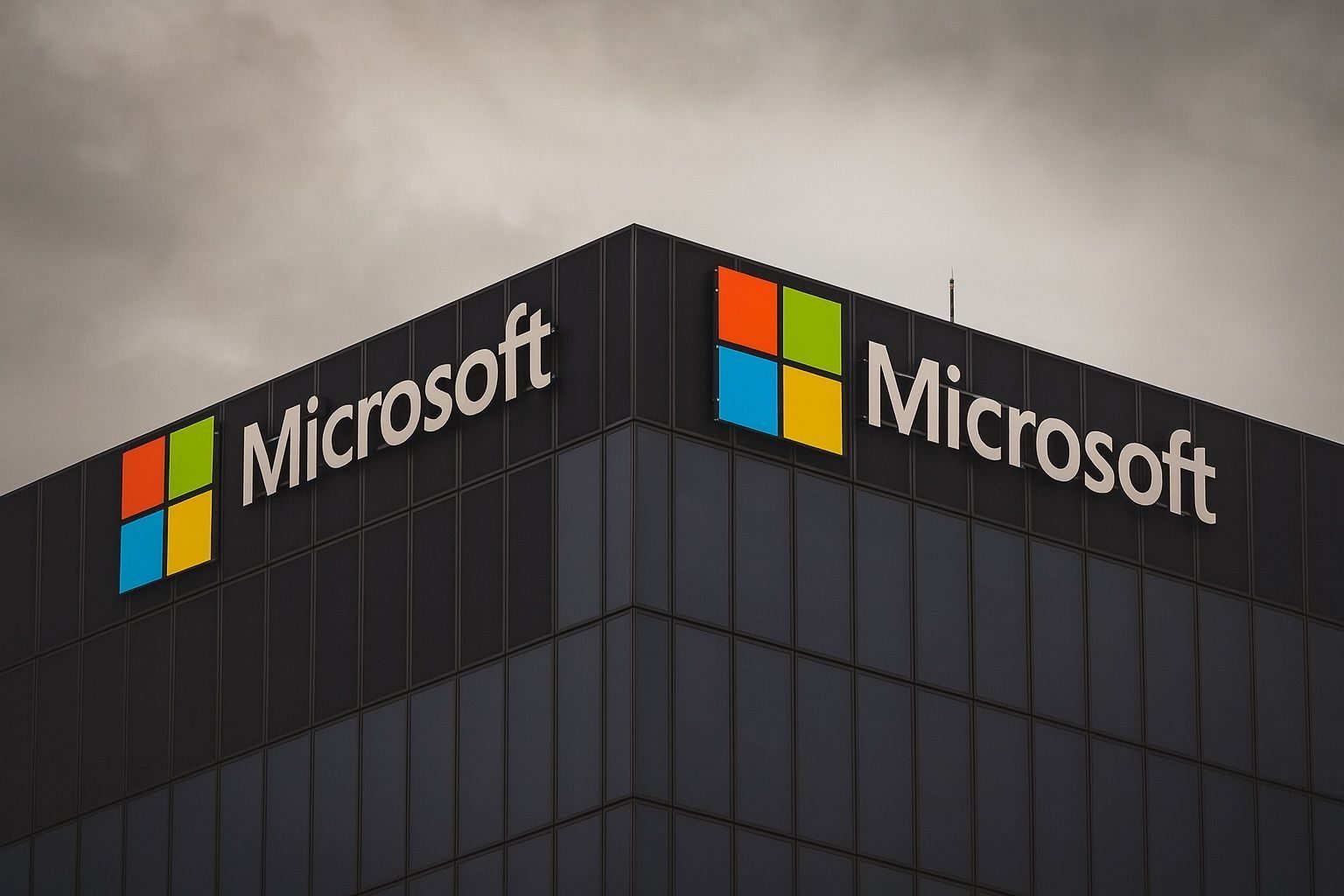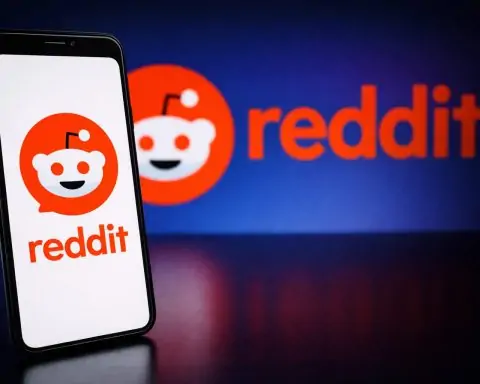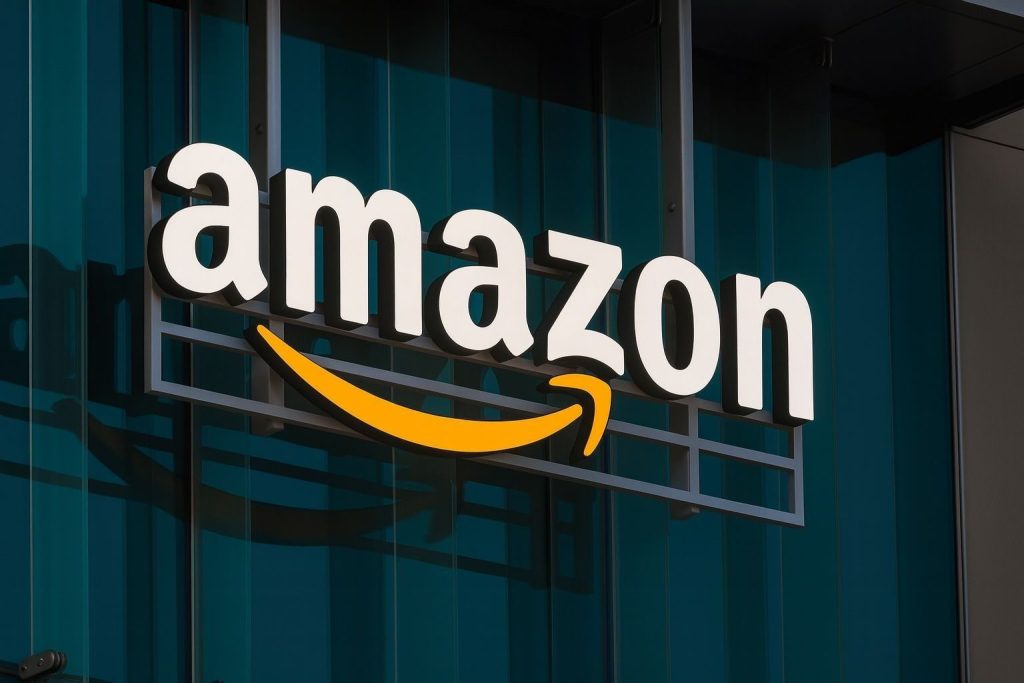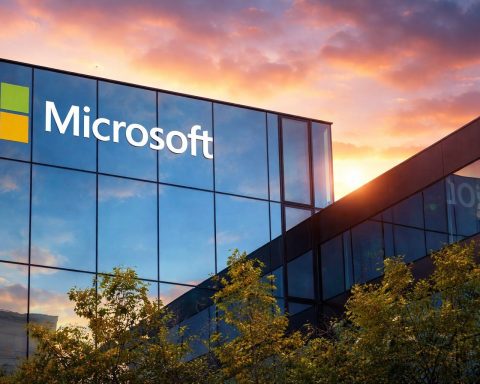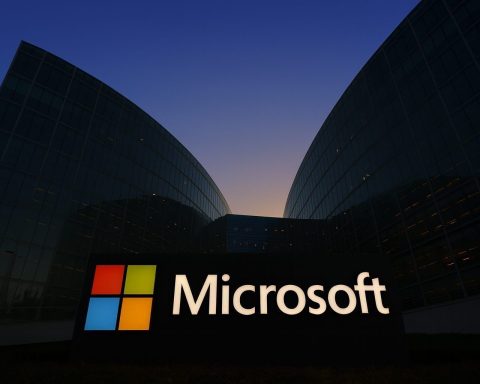Updated: November 28, 2025
Microsoft is reshaping itself around AI and cloud in 2025, with record financial results, a revamped OpenAI partnership, a multibillion‑dollar Anthropic alliance, an AI “superfactory,” and big moves in Xbox gaming and regulators’ courts.
A pivotal year for Microsoft
Microsoft has spent years talking about being an “AI-first” company. In 2025, that slogan finally looks literal.
The company is posting record cloud and AI-driven financials, renegotiating its blockbuster OpenAI deal, striking a huge new alliance with Anthropic and Nvidia, building an AI “superfactory” spanning U.S. states, and pushing agentic AI from the data center all the way down to the Windows desktop. At the same time, regulators in Europe and the U.S. are closing chapters of long‑running antitrust skirmishes, while new probes into the cloud business loom in the background. [1]
Here’s how the Microsoft story looks right now — from earnings and AI strategy to gaming, chips, regulation and jobs.
Cloud and AI power record results
Microsoft’s latest numbers show just how central cloud and AI have become to the business.
In its fiscal 2026 first quarter (for the three months ended September 30, 2025), Microsoft reported: [2]
- Revenue of $77.7 billion, up 18% year-on-year
- Operating income of $38.0 billion, up 24%
- Net income of $27.7 billion (GAAP), up 12%
- Non‑GAAP EPS of $4.13, up 23%
The Microsoft Cloud business alone generated $49.1 billion in revenue, up 26%, driven largely by Azure and other cloud services, which grew 40%. Productivity products like Microsoft 365 and Dynamics 365, plus cloud‑adjacent businesses like LinkedIn, also delivered double‑digit growth. [3]
Full‑year fiscal 2025 results underscore the same story. Microsoft’s revenue hit $281.7 billion, up 15% year-on-year, with operating income up 17%. Intelligent Cloud, which houses Azure, again led the way, while Productivity and Business Processes (Microsoft 365, Dynamics, LinkedIn) and More Personal Computing (Windows, Xbox, search) also grew. [4]
Gaming is increasingly meaningful here. In FY 2025, Gaming revenue rose 9%, with Xbox content and services revenue up 16%, fuelled by the Activision Blizzard acquisition and Xbox Game Pass expansion, although Xbox hardware revenue dropped 25% as Microsoft leans harder into services over consoles. [5]
The flipside: margins. Cloud and AI infrastructure are expensive. Microsoft notes that gross margin percentages in Microsoft Cloud dipped slightly as it scaled out AI infrastructure — although efficiency improvements in Azure and Microsoft 365 are helping offset some of that pressure. [6]
The next chapter of the Microsoft–OpenAI partnership
One of Microsoft’s most consequential moves in 2025 was quietly legal rather than flashy product news: a new definitive agreement with OpenAI, announced on October 28, 2025. [7]
Key changes in the updated partnership include:
- OpenAI’s new corporate structure: Microsoft supports OpenAI’s shift to a public benefit corporation (OpenAI Group PBC) and now holds an investment valued at roughly $135 billion, representing about 27% on an as‑converted diluted basis. [8]
- Extended IP and Azure rights: Microsoft remains OpenAI’s frontier model partner, with exclusive IP rights and Azure API exclusivity for OpenAI’s frontier models through at least 2032, including models developed post‑AGI under certain safety and governance checks. [9]
- More freedom on both sides:
- OpenAI can now jointly develop products with third parties. If those products are API‑based, the APIs remain exclusive to Azure; non‑API products can run on other clouds.
- Microsoft, crucially, is now free to pursue AGI independently or with other partners, even while OpenAI remains its primary frontier model provider. [10]
- Massive Azure commitment: OpenAI has contracted to purchase an additional $250 billion of Azure services, while Microsoft relinquishes its previous right of first refusal over OpenAI’s compute. [11]
In short, Microsoft keeps privileged access to OpenAI’s frontier models and research, but no longer bets its entire AI future on OpenAI alone. That opens the door to a broader multi‑model, multi‑partner strategy.
Anthropic, Nvidia and a multi‑model AI stack
Microsoft wasted no time using that new flexibility. In November, AI company Anthropic announced a huge expansion of its relationship with Microsoft and Nvidia: [12]
- Anthropic will buy $30 billion worth of Azure compute capacity, with the option to scale up to one gigawatt of infrastructure.
- In return, Microsoft and Nvidia plan to invest up to $5 billion and $10 billion respectively in Anthropic.
- Anthropic’s Claude models will be available across Microsoft enterprise products, including Microsoft Foundry, GitHub Copilot, Microsoft 365 Copilot, and Copilot Studio.
- Anthropic says this makes Claude the only frontier model offered across all major global cloud providers, positioning it as a true cloud‑agnostic option.
At Microsoft Ignite 2025, the company also confirmed that Anthropic models will join OpenAI’s within Microsoft 365 Copilot, giving enterprise customers a choice of model for different workloads and compliance needs. [13]
This multi‑model strategy is central to Microsoft’s pitch: it wants Azure and Copilot to be the place where enterprises can mix and match models from Microsoft, OpenAI, Anthropic and others, rather than tying themselves to a single AI provider.
Ignite 2025: Copilot, Work IQ and Agent 365
At Microsoft Ignite 2025, the company tried to answer a question many enterprises are asking: “How do we turn AI hype into real productivity?” Its answer revolves around Copilot, Work IQ and AI agents. [14]
Some of the biggest announcements:
- Work IQ – an “intelligence layer” that lets Microsoft 365 Copilot understand your job, your company’s knowledge, and your work patterns by drawing on emails, files, meetings and chats (with existing permissions and compliance controls). [15]
- Word, Excel and PowerPoint agents in chat – Office apps now have agents that can work iteratively with you inside Copilot or in the apps themselves, helping draft documents, build models and design presentations. [16]
- Agent 365 – essentially a control plane for AI agents, giving IT and security teams one place to deploy, govern and monitor “thousands” of agents across the organization, with deep hooks into Microsoft Defender, Entra and Purview. [17]
- Employee Self‑Service (ESS) agent – a ready‑made HR/IT support agent that brings employee requests and routine tasks into Copilot, integrated with systems like Workday, ServiceNow and SAP SuccessFactors. [18]
Microsoft says over 90% of the Fortune 500 now use Microsoft 365 Copilot, and it has shipped more than 400 new features in the last year, powered by models ranging from GPT‑5 to Sora 2 and computer‑use agents. [19]
Analysts and Microsoft’s own partners increasingly talk about “Frontier Firms” — organizations that are human‑led but agent‑operated, where AI agents are treated as a new kind of digital workforce with KPIs, governance and security controls, not as experimental side projects. [20]
AI infrastructure: Microsoft’s first “AI superfactory” and custom silicon push
To feed all of this AI demand, Microsoft is racing to build unprecedented infrastructure.
Fairwater and the AI superfactory
In November, Microsoft unveiled what it calls the world’s first AI “superfactory”: a network of next‑generation Fairwater AI datacenters starting in Wisconsin and Atlanta, linked by a dedicated high‑speed fiber network. [21]
Unlike traditional cloud datacenters that juggle millions of small workloads, Fairwater sites are designed to act as one giant, distributed computer that can train and run massive AI models across:
- Hundreds of thousands of GPUs
- Exabytes of storage
- Millions of CPU cores, coordinated using a purpose‑built AI Wide Area Network (AI‑WAN)
These facilities use advanced liquid cooling and more water‑efficient designs, reflecting rising concerns about the energy and environmental footprint of generative AI. Microsoft says the superfactory will power workloads for OpenAI, Microsoft’s MAI Superintelligence team, Copilot and other large‑scale AI systems. [22]
The superfactory is part of a broader multi‑year, multi‑tens‑of‑billions dollar investment in AI datacenters, including more than $80 billion earmarked for hyperscale AI regions, custom chips and liquid‑cooled GPU clusters worldwide. [23]
Custom chips: Cobalt and Maia
Running all this on off‑the‑shelf GPUs would be ruinously expensive. Microsoft has been steadily ramping its in‑house silicon, including:
- Cobalt CPUs – Arm‑based chips optimized for Azure workloads, with the new Cobalt 200 promising up to 50% better performance than its predecessor for many real‑world cloud workloads, plus built‑in accelerators for compression and encryption. [24]
- Maia AI accelerators – custom AI chips designed to run large model training and inference, freeing up scarce Nvidia GPU capacity and giving Microsoft more control over cost and performance. [25]
Industry reports suggest Microsoft aims, over time, to rely primarily on its own chips for many AI workloads, reducing dependence on Nvidia and AMD even as it continues to buy their hardware at scale. [26]
MAI Superintelligence: aiming for domain‑specific “humanist” super‑AI
In early November, Microsoft announced the MAI Superintelligence Team, led by AI chief Mustafa Suleyman(co‑founder of DeepMind). The goal: build domain‑specific “humanist superintelligence”, starting with medical diagnosis, rather than a general‑purpose AGI. [27]
The team plans to focus on:
- Superhuman systems for disease detection and diagnosis, with the aim of identifying preventable conditions earlier.
- Other domains with high societal impact, such as battery technology and molecular design.
- A safety philosophy that emphasizes practical benefits and avoids science‑fiction‑style existential risk narratives, at least in public positioning.
Suleyman has suggested that medical superintelligence could be achievable within two to three years, though that timeline will depend on both technical progress and regulatory approval. [28]
This initiative complements Microsoft’s deeper investments in its own models, including its first in‑house text‑to‑image model, MAI‑Image‑1, which launched in October and is already being benchmarked against top image generators. [29]
From cloud to desktop: Fara‑7B and agentic AI on your PC
Not all AI progress is happening in the cloud. Microsoft is also pushing agentic AI that runs locally on user devices.
In late November, the company unveiled Fara‑7B, described as a “Computer Use Agent” — a 7‑billion‑parameter model designed to operate directly on PCs and perform complex tasks by interacting with the user interface like a human would. [30]
According to early reports:
- Fara‑7B runs entirely on local hardware, avoiding round‑trips to the cloud, which improves latency and privacy.
- It “looks” at screenshots at the pixel level, then decides where to click, type or scroll — even when the underlying webpage or app code is messy or inaccessible.
- In a standard benchmark for web agents, Fara‑7B scored 73.5%, outperforming OpenAI’s GPT‑4o at 65.1%, highlighting how specialized agents can beat larger general models at specific tasks. [31]
- To limit risk, Microsoft trained Fara‑7B to detect “Critical Points” (e.g., when actions involve sensitive data or require consent) and pause for human approval.
Because all visual data and reasoning stay on the device, Microsoft pitches Fara‑7B as particularly attractive for regulated industries like healthcare and finance, where cloud‑based automation can be hard to approve. [32]
Gaming: Activision integration, Game Pass growth and Retro Classics
On the consumer side, Microsoft’s Xbox and gaming division is finally realizing the full impact of its $68.7 billion acquisition of Activision Blizzard, which officially closed in October 2023. [33]
Revenue and Game Pass milestones
Microsoft’s 2025 Annual Report notes that gaming revenue grew 9%, with Xbox content and services up 16%, driven by the Activision Blizzard catalog and continued expansion of Xbox Game Pass. [34]
This year, Microsoft disclosed that Xbox Game Pass generated nearly $5 billion in annual revenue for the first time, marking a record for the subscription service and underscoring the company’s shift from pure hardware sales toward recurring gaming subscriptions and cross‑platform releases. [35]
At the same time, Microsoft has revamped Game Pass tiers and pricing, adding more games across Essential, Premium and Ultimate tiers while making cloud gaming fully commercial and bundling services like Ubisoft+ Classics and Fortnite Crew for high‑end subscribers. [36]
Retro Classics and Activision’s back catalogue
One of the most visible Activision‑driven moves in 2025 is Retro Classics, a collection of over 50 vintage Activision games from the 1980s and 1990s added to Game Pass, with plans to grow the library to more than 100 titles. [37]
Games like Pitfall!, MechWarrior 2 and other early Activision hits are now playable on Xbox, PC and supported smart TVs or VR devices via cloud gaming. Microsoft is positioning Retro Classics as part of a broader game preservation and backward‑compatibility strategy, akin to Nintendo’s classic libraries, while also monetizing Activision’s back catalogue for a new generation of players. [38]
Regulation: Cloud scrutiny rises as some cases close
Microsoft’s global regulatory environment remains complex — but 2025 brought a mix of relief and new questions.
Wins in France and the U.S.
- In France, the competition authority dismissed an antitrust complaint from local search engine Qwant, which had accused Microsoft of abusing its dominance through restrictions tied to Bing. Regulators said Qwant’s evidence was not convincing enough and declined to impose interim measures. [39]
- In the United States, the long‑running FTC case seeking to block the Activision Blizzard acquisition effectively ended when the Ninth Circuit Court of Appeals denied the FTC’s request for an injunction in May 2025, and the FTC subsequently dropped the case later that month. [40]
These decisions remove two significant overhangs on Microsoft’s gaming and search strategies.
New pressure in European cloud
At the same time, Europe is intensifying scrutiny of cloud computing:
- The European Commission has opened a formal investigation into whether Microsoft and other big cloud providers are using software licensing and other practices that unfairly lock customers into their platforms. [41]
- Shortly after that probe began, Google withdrew its own EU antitrust complaint about Microsoft’s cloud licensing, saying it would instead cooperate with regulators in the broader sector‑wide investigation. [42]
If EU regulators conclude Microsoft is a “gatekeeper” under the Digital Markets Act in cloud, the company could face additional obligations and potential restrictions on how it bundles cloud services and software.
Global expansion and geopolitics: UAE chip deal
Microsoft’s AI ambitions are also reshaping its geopolitical footprint.
Earlier in November, the company announced it will ship more than 60,000 of Nvidia’s most advanced GB300‑series AI chips to the United Arab Emirates, under a U.S. Commerce Department‑approved deal that is part of a broader $15.2 billion investment in UAE technology infrastructure. [43]
The chips will power Azure data centers serving AI models from OpenAI, Anthropic, Microsoft and open‑source providers, under what both sides describe as stringent security and governance commitments. The UAE, in turn, has pledged massive investment in U.S. energy and AI sectors, signaling how AI infrastructure is becoming a major lever in international economic relationships. [44]
Workforce and restructuring: growth with painful cuts
Behind the glossy AI announcements, 2025 has also been a difficult year for many Microsoft employees.
Public filings and reports indicate that: [45]
- Microsoft laid off around 1,900 employees in its gaming division in early 2024, mainly at Activision Blizzard and some Xbox/ZeniMax teams.
- In May 2025, the company announced layoffs affecting more than 6,000 employees (about 3% of its workforce), followed by another round in July 2025 cutting approximately 9,000 positions, including hundreds in its Redmond headquarters.
- Amid these cuts, Microsoft also exited Pakistan after 25 years, citing a shift toward cloud‑based models and growing difficulties with the local business environment.
These moves highlight a tension at the heart of Microsoft’s transformation: even as revenue, profits and AI investments soar, the company is aggressively reallocating headcount and resources toward cloud, AI and high‑growth areas — and away from slower‑growth or legacy lines of business.
What it all means for Microsoft’s future
Put together, Microsoft’s 2025 story looks something like this:
- Financially, cloud and AI are delivering robust top‑ and bottom‑line growth, even as AI infrastructure spending compresses margins in some segments.
- Strategically, Microsoft is becoming a platform for multiple frontier models (OpenAI, Anthropic and its own MAI models), with Copilot and agents as the primary user experience layer.
- Technically, the company is building an end‑to‑end stack — from in‑house chips (Cobalt, Maia) and an AI superfactory of Fairwater datacenters to local agents like Fara‑7B and domain‑specific superintelligence projects in healthcare and beyond.
- Regulatorily, some big lawsuits (like the FTC’s Activision challenge and Qwant’s complaint) are behind it, but new scrutiny in cloud and ongoing questions about AI competition and safety remain.
- In consumer and gaming, Microsoft is doubling down on services, subscriptions and back catalog value via Game Pass, Activision integration and retro libraries, while accepting weaker hardware sales as part of that trade‑off.
For customers and partners, the signal is clear: Microsoft is betting its future on being the infrastructure, tools and agent layer for the AI economy, not just a maker of Windows and Office.
For rivals in cloud, AI and gaming, 2025’s moves — from the AI superfactory and custom chips to multi‑billion‑dollar model alliances — underline how hard it will be to match Microsoft’s scale, even as regulators work to keep that power in check.
References
1. www.microsoft.com, 2. www.microsoft.com, 3. www.microsoft.com, 4. www.microsoft.com, 5. www.microsoft.com, 6. www.microsoft.com, 7. blogs.microsoft.com, 8. blogs.microsoft.com, 9. blogs.microsoft.com, 10. blogs.microsoft.com, 11. blogs.microsoft.com, 12. www.techradar.com, 13. www.microsoft.com, 14. www.microsoft.com, 15. www.microsoft.com, 16. www.microsoft.com, 17. techcommunity.microsoft.com, 18. techcommunity.microsoft.com, 19. www.microsoft.com, 20. www.microsoft.com, 21. news.microsoft.com, 22. news.microsoft.com, 23. www.datacenters.com, 24. www.techradar.com, 25. news.microsoft.com, 26. www.trendforce.com, 27. www.reuters.com, 28. www.reuters.com, 29. www.theverge.com, 30. www.windowscentral.com, 31. www.windowscentral.com, 32. www.windowscentral.com, 33. news.microsoft.com, 34. www.microsoft.com, 35. www.techradar.com, 36. en.wikipedia.org, 37. www.theverge.com, 38. www.theverge.com, 39. www.reuters.com, 40. en.wikipedia.org, 41. www.reuters.com, 42. www.reuters.com, 43. apnews.com, 44. apnews.com, 45. en.wikipedia.org
